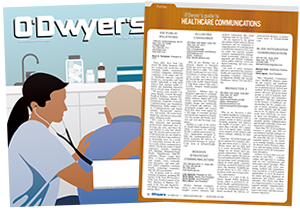 John Carnett John Carnett |
|
|
With all of these technological advances, which are often incomprehensible to most consumers, it is no wonder why many individuals are fearful of seeking treatment or visiting a doctor. David Yusko, Clinical Director at the University of Pennsylvania’s Center for the Treatment and Study of Anxiety, has estimated that roughly three percent of the U.S. population has even developed a clinical phobia of visiting the doctor’s office. It is a fact that people fear the unknown and although a new treatment or medical device can be highly effective, consumers do not want to risk their health for an item they know nothing about. As a PR practitioner it is our job to alleviate these fears by listening to our consumer and letting their voice shape our PR strategy.
Importance of the voice of the consumer
Listening to the consumer and acting on what they are saying not only gives your business a significant competitive edge but has also been shown to immeasurably improve your bottom line. By listening and analyzing what your consumers say, you are able to piece together an in-depth understanding of their preferences and their actions. These tactics can be used to create and implement very powerful marketing strategies in which you engage and develop relationships with those consumers, creating repeat customers and brand advocates that drive word-of-mouth customer acquisitions.
Some of the direct benefits associated with listening to the voice of the consumer include: identifying threats to your brand’s reputation before it becomes a problem, being able to customize your product or service to better meet the needs of your customer, being able to address unforeseen consumer questions, having the ability to track marketing efforts to evaluate success, ensuring regulatory compliance in messaging, gathering product quality feedback as well as the ability to provide positive customer testimonials and more for your marketing efforts. Simply put, there are plenty of benefits to understanding the voice of your consumer that the effort is worth it overall.
Advancements in consumer listening
With all of the current medical advances, PR agencies focusing on the healthcare industry need to keep up. There is a tremendous amount of data available to analyze, strategize, and monetize, but instead many companies keep departments in silos and lose information that could be potentially vital to a campaign. For instance, a marketing department currently has the ability to monitor online conversations occurring via blog sites and social profiles, or even analyze online traffic and e-commerce to gather significant marketing and sales data, but there is often no communication between marketers and call centers. With call centers being a major driving force behind both customer service and sales, the data that can be extracted from those calls can be invaluable. Instead this data is overlooked or even discarded because it is deemed to be too much of a hassle to integrate with current marketing data.
The technology needed to analyze call center data is already here with services such as Sentio360, an automated speech recognition / natural language understanding platform. By combining this data with traditional online data, a marketer can finally have a complete understanding of the voice of the consumer, gathering consumer sentiment, keywords, relevant conversations and ensure regulatory compliance both online and offline. Many successful companies outside of the healthcare industry are already realizing the need to increase the use of technology within their marketing and customer service departments. Quoted in an Entrepreneur article, Janet Song, SVP of Member Services for Dollar Shave Club, says the company is a big believer in using technology to help create a rich understanding of its members which, in turn, aids in delivering an outstanding customer experience. For reference, the Dollar Shave Club has more than 3.2 million happy, returning customers and was recently purchased for $1 billion by Unilever.
Shaping your strategy
There are many key data points along the customer’s decision journey that we should be looking at from a marketing standpoint. We need to pinpoint phrases that 1) tap into the customer’s needs/wants, 2) reference the customer’s biggest pain points, 3) key into the customer’s hesitations or concerns about purchasing, and 4) could be potentially damaging to the brand. As conversations are sifted through and statements arise such as, “can this product help with [insert health concern]?” or even, “This pill is giving me headaches and I didn’t see any information about this ...” PR experts should identify keyword trends that bring to light the consumer’s insight regarding product or services, common hurdles felt when trying to use or purchase the product, or even product defaults/side effects that could potentially be damaging to the brand.
This insight can be used to be solution oriented in PR communications activities by addressing the primary concerns of the consumer. By understanding the overall consumer sentiment, finding prevalent keywords, and discovering potential threats to the brand we are provided with ammunition to shape an effective PR strategy and alter an individual’s purchasing decisions by making them feel both educated and understood.
With new available technology, such as Sentio360, we are now able to uncover all of our customer interactions in a cost-effective manner and transform this data into meaningful and actionable content and messaging. When used effectively this content will aid in generating positive brand sentiment, goodwill toward the brand and a measurable outcome from a reputation management perspective.
As Kevin Spacey said in his speech at the Edinburgh Television Festival in 2013 about the key to his success: “Give people what they want, when they want it, in the form they want it in.” Though he was referring to the film industry, his message of success is just as relevant to the healthcare industry. In summary, to find success you need to understand your consumer. The best way to know your consumer … simply listen.
* * *
John Carnett leads Marketing Maven’s consumer research and campaign analytics.



 Lo Isidro, senior director at Real Chemistry with more than a decade of strategic communications and PA experience, has joined Narrative Strategies.
Lo Isidro, senior director at Real Chemistry with more than a decade of strategic communications and PA experience, has joined Narrative Strategies. Nelson Fernandez, former North American chair of APCO Worldwide and managing director of Burson-Marsteller, has joined Volunteers in Medicine Berkshires as director of communications and PA.
Nelson Fernandez, former North American chair of APCO Worldwide and managing director of Burson-Marsteller, has joined Volunteers in Medicine Berkshires as director of communications and PA. Lilit Bargar, who was most recently an EVP in the healthcare practice at Weber Shandwick, comes on board at GCI Health as EVP, corporate practice lead.
Lilit Bargar, who was most recently an EVP in the healthcare practice at Weber Shandwick, comes on board at GCI Health as EVP, corporate practice lead.
 Five ways that successful thought leaders are made.
Five ways that successful thought leaders are made.


 Have a comment? Send it to
Have a comment? Send it to 
No comments have been submitted for this story yet.